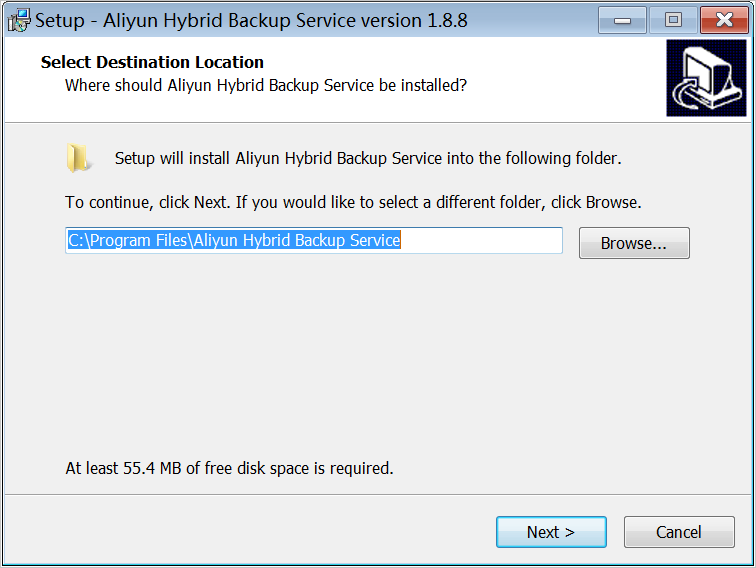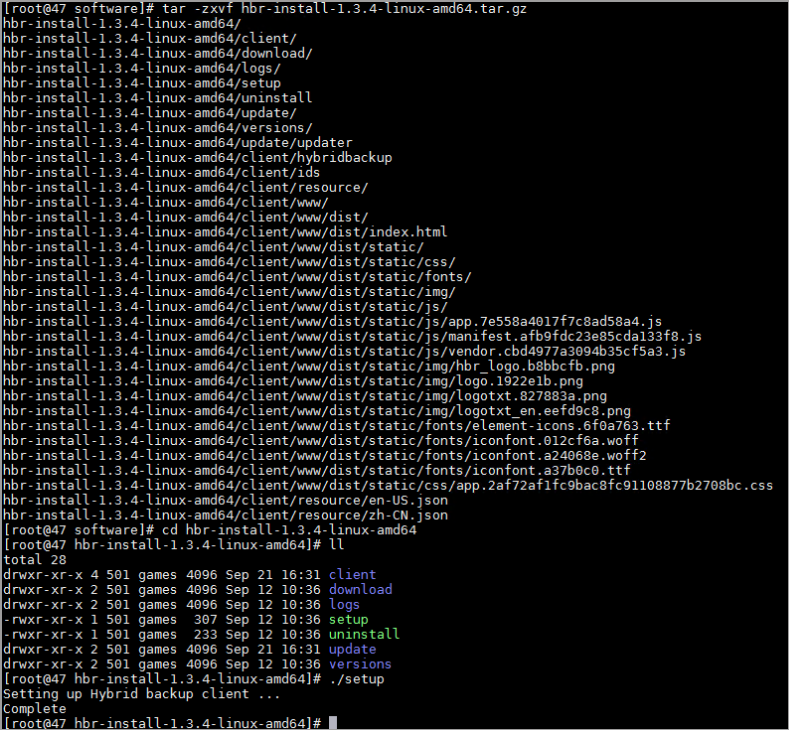This topic describes how to configure a Windows server as a proxy server for the host of a backup client.
Prerequisites
A proxy server is built.
If you encounter any problems when building a proxy server, see Step 1: Prepare a proxy server. This step describes the method to build the Apache HTTP server as a proxy server on Windows. The Apache HTTP server is a third-party service that is not provided by Cloud Backup. The method is for reference only.
Background information
If the host from which you want to back up data cannot access the Internet, you can configure a proxy server for the host.
Step 1: Prepare a proxy server
Prepare a server that has the Internet access.
Install Microsoft Visual C++ Redistributable for Visual Studio 2015-2019.
Download and decompress the package of Apache HTTP Server 2.4.
Modify the configuration file named Apache24\conf\httpd.conf.
NoteChange the path in Define SRVROOT "\Apache24" to the installation directory of Apache. For example, if Apache is installed in the root directory of the D drive, you can change the path to D:\Apache24.
Load modules.
LoadModule proxy_module modules/mod_proxy.so LoadModule proxy_connect_module modules/mod_proxy_connect.so LoadModule proxy_ftp_module modules/mod_proxy_ftp.so LoadModule proxy_http_module modules/mod_proxy_http.soSpecify the listening port, for example,
Listen 8888.Set access permissions.
ProxyRequests On ProxyVia On <Proxy *> Require all granted </Proxy>
Double-click
Apache24\bin\httpd.exeto start the proxy service.
Step 2: Create a backup client
Log on to the Cloud Backup console.
If the host runs a Linux operating system without a graphical user interface (GUI), use an intermediate host with a GUI as an agent to log on to the Cloud Backup console.
In the left-side navigation pane, choose .
In the top navigation bar, select the region where you want to store backup data.
NoteIf you use a virtual private cloud (VPC), select the region of the VPC. This guarantees a high backup speed.
If you do not use a VPC and you need to achieve optimal backup performance, select a region that is close to the location of the data that you want to back up.
If you do not use a VPC and you need to implement disaster recovery, select a region that is distant from the location of the data that you want to back up.
In the On-Premises Backup File page, click Add Client.
In the Add Client pane, set the parameters.

Parameter
Description
Backup Vault
The backup vault where you want to store the backup data. A backup vault is a repository that Cloud Backup uses to store backup data. You can use a single vault to store backup data that is received from multiple backup clients. Backup vaults reside in different regions. You can select or create only a backup vault in the current region.
If you have created backup vaults, click Select Vault, and select a backup vault from the Vault Name drop-down list.
If you have not created backup vaults, click Create Vault and specify the Vault Name field. The name must be 1 to 64 bytes in length.
Backup Client
The backup client that you want to add. You can select an activated client or create a client.
Client Name
The name of the backup client. The name must be 1 to 64 bytes in length.
Software Platform
The operating system that is running on the host from which you want to back up data. Valid values:
Windows 32-bit
Windows 64-bit
Linux 32-bit
Linux 64-bit
Network Type
Virtual Private Cloud (VPC): Select this option if the host from which you want to back up data resides in a VPC and the VPC is in the same region as the backup vault.
Public Network: Select this option if no VPCs are available.
Use HTTPS
Specifies whether to use HTTPS for encrypted data transmission. Note that HTTPS compromises the performance of data transmission. Data that is stored in the backup vault is encrypted, regardless of the setting of this switch. If you modify the setting of this parameter, the modification takes effect on the next backup or restore job.
Click Create. Then, click Download Client.
NoteThe backup client is used to connect the host to Cloud Backup. You can also download the backup client from the client list.
Click Download Certificate.
Step 3: Install the backup client
Select an installation directory, decompress the installation package, and then install the backup client.
Make sure that enough space is available in the installation directory because operational logs and an executable file are all stored in the installation directory.
If the host runs Windows, run the executable file that is decompressed from the installation package, select an installation directory, and then follow the instructions to install the backup client.

If the host runs Linux, decompress the installation package to a specified directory and run the
./setupcommand to install the backup client.
Step 4: Activate the backup client
After the backup client is installed, you can use the following methods to activate the backup client.
Recommended. Activate the backup client in the Cloud Backup console.
Log on to the Cloud Backup console.
On the On-Premises Backup page, click File. Find the backup client and choose in the Actions column. In the Activate Client step of the Add Client pane, set the following parameters.

Parameter
Required
Description
Client IP Address
Yes
The IP address of the backup client that your current host can access. You can specify an internal IP address or an Internet IP address. For example, the IP address can be 127.0.0.1 (default), 12.34.56.78:8011, or 87.65.43.21:8443.
NoteThe IP address must be reachable from your browser in use.
AccessKey Id
Yes
The AccessKey ID and AccessKey secret of the RAM user that is used to access Cloud Backup. For more information, see How do I create an AccessKey pair for a RAM user?.
AccessKey Secret
Yes
Client Password
Yes
The password that is used to log on to the backup client. The password must be at least six characters in length
Data Network Proxy
No
The information of the proxy server that is used to transmit backup data. Specify the information if a proxy server is used for data transmission.
NoteYou can configure a data network proxy only for a backup client whose version is 1.11.11 or later.
Control Network Type
No
The type of the network that is used to call the Cloud Backup API.
Control Network Proxy
No
The information of the proxy server that is used to call the Cloud Backup API.
Message Channel Network Type
No
The type of the network that is used to send messages from Cloud Backup to the backup client.
Click Activate Client.
The page of the backup client for files appears. You can then use the backup client to back up data. If the activation of a backup client fails, you can reactivate the client. For more information, see How can I reactivate a file backup client?
Activate the backup client on the host
Enter the URL of the backup client in a browser to log on to the backup client. The URL is in the format of http://<Client IP address>:<Port number>, for example, http://10****:8011.
On the Register page that appears, set the following parameters and click Register.
Parameter
Required
Description
Certificate File
Yes
The certificate of the backup client. Upload the certificate that you downloaded in Step 2: Create a backup client.
AccessKey Id
Yes
The AccessKey ID and AccessKey secret of the RAM user that is used to access Cloud Backup. For more information, see How do I create an AccessKey pair for a RAM user?.
AccessKey Secret
Yes
Backup Data Network
No
The type of the network over which backup data is transferred. You can select Public Network or Alibaba Intranet.
Control Network Proxy
No
The information of the proxy server that is used to call the Cloud Backup API. The information includes the username, password, IP address, and listening port number of the proxy server.
If identity authentication is not required, leave the username and password unspecified.
Data Network Proxy
No
The information of the proxy server that is used to transmit backup data. Specify the information if a proxy server is used for data transmission.
The information includes the username, password, IP address, and listening port number of the proxy server. If identity authentication is not required, leave the username and password unspecified.
Control Network Type
No
The type of the network that is used to call the Cloud Backup API.
Message Channel Network Type
Yes
The type of the network that is used to send messages from Cloud Backup to the backup client.
After the backup client for files is activated, you can use it to back up files.